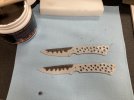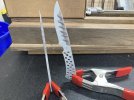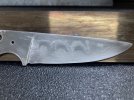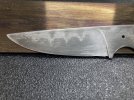Bühlmann
North Lake Forge
- Joined
- Jan 6, 2022
- Messages
- 475
So this was my first attempt. Blade was hand sanded to 400gr before applying clay. I used 26C3 from AKS, a thin coat of NoScale 2000 over the entire blade, and two coats of Hamon 1800 on the spine:


Here is the post HT result after hand sanding to 1000gr followed by about 6 ferric chloride dips (approximately 15-20 sec each) with a 1200gr wet sand between dips:



I don’t like it at all. I don’t understand the blotchiness or the lack of uniformity. What can I improve and/or change to get a better visual representation?


Here is the post HT result after hand sanding to 1000gr followed by about 6 ferric chloride dips (approximately 15-20 sec each) with a 1200gr wet sand between dips:



I don’t like it at all. I don’t understand the blotchiness or the lack of uniformity. What can I improve and/or change to get a better visual representation?


